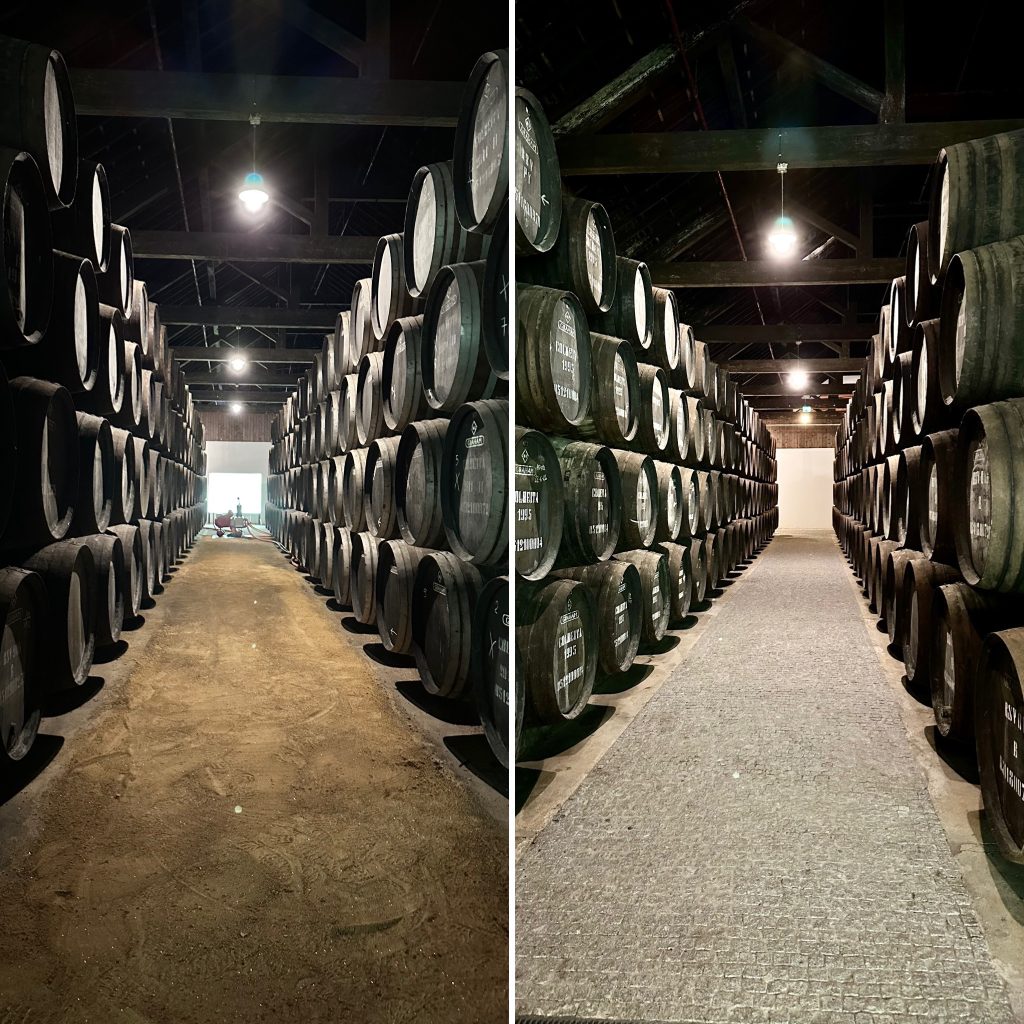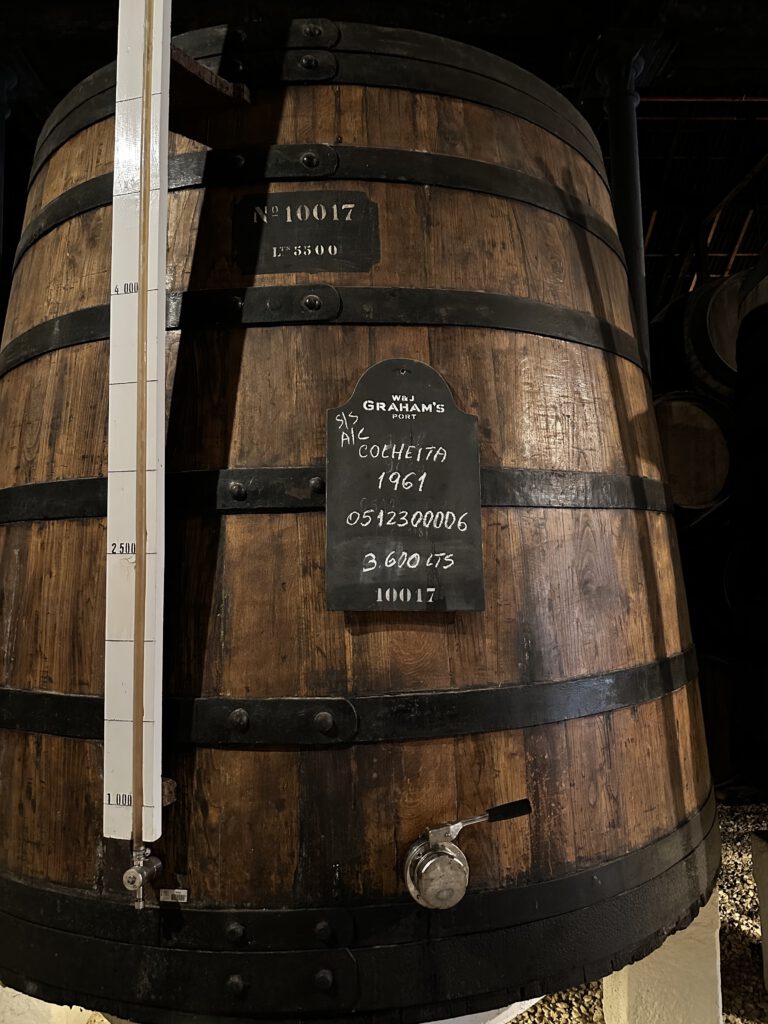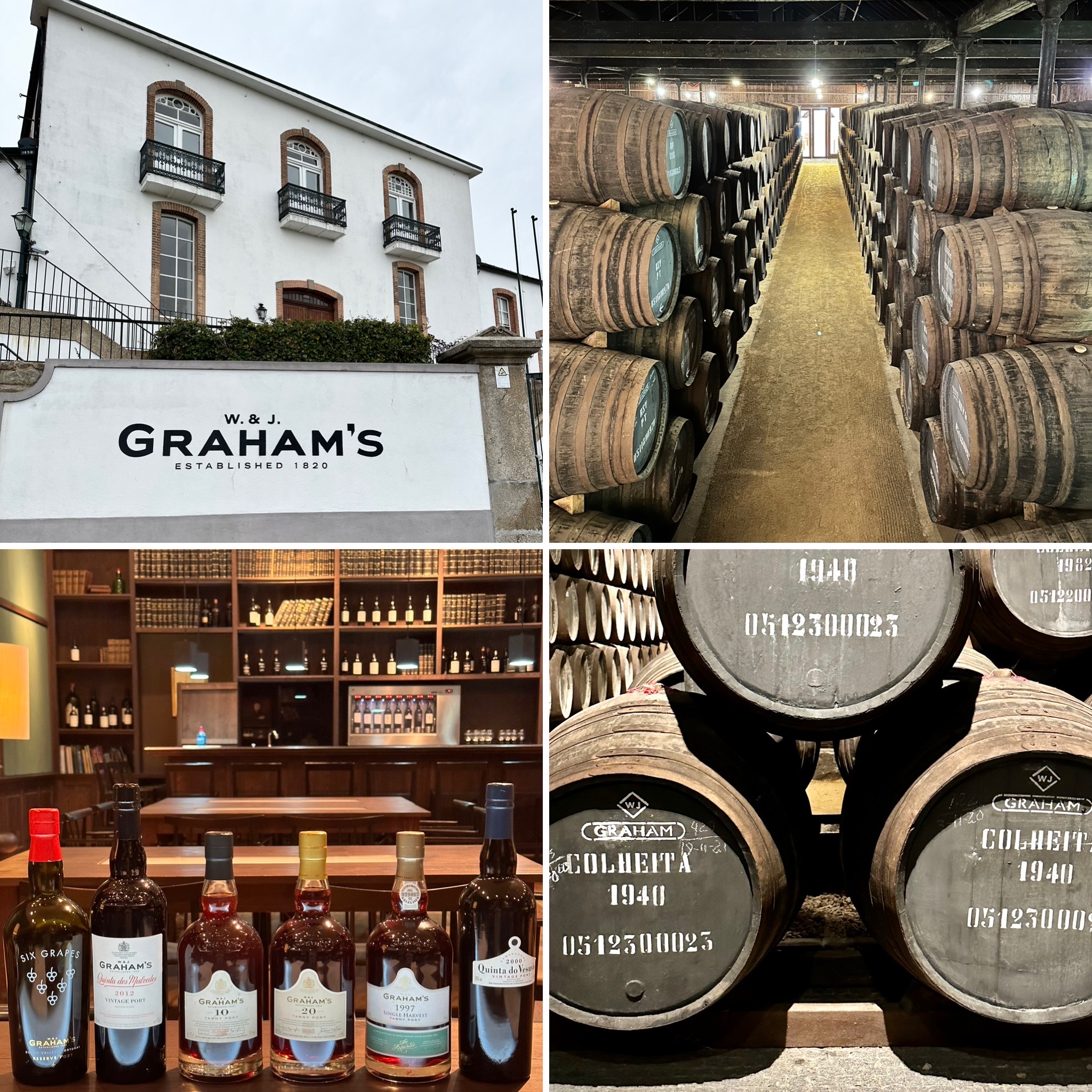Graham’s Port – Symington Family Estate.
Recently we visited Porto and Douro regions, famous for producing the iconic Port wines and a recent trend, high-quality dry wines. The highlight of the trip was visiting Graham’s Lodge in Villa Nova de Gaia and learning about the history of the Symington Family Estate, some regional topics, their grape growing and winemaking, and their environmental approach. We walked through a vast labyrinth of barrels and encountered stories behind the iconic wine, followed by an excellent tasting in a special room. However, we were most impressed with their responsibility as the top producer. This exciting story was something that we learned from Nuno Silva at Graham’s Port.
Port Wine Business
Port wine is a sweet, fortified wine made with grapes from the Douro region. Its history started in the 17th Century by adding brandy to stabilize dry wines and ensure they were in good condition after transportation to England. Porto was the only harbor for export until the middle of the 20th Century, and Villa Nova de Gaia, in front of Porto, was a perfect maturation place for most Port winemakers from the climatic and management perspective. Now, walking on the Dom Luís I Bridge and looking over the Villa Nova de Gaia, you will see a range of Port Lodges lined up in a row.
Port wine is the art of blending. In general, a 40-year-old Port means an average of 40 years old. To make Port wine of this age, a Port winemaker blend from its own stocks or get Port wines from the 50, 60, and sometimes 100 years old market; nowadays, Port winemakers started to grow their own grape.
Port winemakers produce a range of styles in line with the trend; Ruby Port is an easy-drinking young wine: Vintage Port is the best wine, that is declared a couple of times in a decade; Single Quinta is the second-best wine from a single vintage and single vineyard when the producer does not produce a Vintage Port; Consumers have to wait to see the drinking window for those two categories, and hence Late Bottled Vintage (LBV) is a good alternative, which is ready to drink wine on its release as being aged before bottling; Tawny Port is an oxidative style aged in small casks, with complex nutty aromas. Port wines are indeed classic and innovative.

Symington Family Estate
Symington is the fourth and fifth generation after Andrew James (‘AJ’) Symington arrived in Portugal from England and established a company on its name. Still, their linkage to Port wines was back to the 17th century, as AJ married a Proto-born Port wine merchant. Since then, the family-owned company has had faith in the Porto and commitment to the Douro. Today 10 family members are working across the business, committed to producing the finest Port wines. They are also a member of the premium family association, where Château Mouton Rothschild, Château Haut-Brion, Sassicaia – Tenuta San Guido, Familia Torres, and Gaja also join and collaborate for the future wine industry.
Graham’s is part of Symington Family Estate, a family-owned company that owns 26 wineries (1,000 hectares) including a number of well known Port producers. Graham’s is the premium range; Cockburn’s is light and casual, meaning a more modern style; Dow’s is drier on the palate by stopping fermentation later than Graham’s; Quinta de Vesuvio is exceptional sourcing the best grapes from Douro Superior, made using the traditional method.
The family has owned several vineyards; Quinta dos Malvedos is a traditional stone terraced vineyard at the center of Douro Valley, which has been the cornerstone of Graham’s Vintage Port ever since 1890; Quinta do Vesuvio is a model case with the best quality grapes and the centuries-old treading method. As a tradition in the Porto business, the family has also worked with many grape growers, yet based on a long period of contract with care and supervision.
Tradition and innovation have been combined in winemaking too. For example, traditional extraction methods, foot treading in Lagares, have been imitated by robotic Lagares with silicon ‘feet’ since 2000. The one exception is Quinta do Vesuvio, where all their port wines are still trodden entirely by foot, by teams of up to 50 people in the enormous Lagares.

Sustainability
Recent environmental-approaching projects have progressed after new generations joined the Estate with innovative minds. As one of them, Quinta Do Tua is the first vineyard to be biodynamically certified and has been used for experimenting projects to plant grapes only with natural resources such as solar panels. In addition, they’ve planted 50 indigenous varieties in the vineyard as a library for research with climate change in mind. Recently Symington led the sustainable project and was certified as Portugal’s first B Corp company.
Environmental approach needs comprehensive care, and the Symington family has been implementing its changes. Some packaging has been updated from two-sided to one-sided, halving the workload, paper, and energy consumption. The weight of the bottle has been lightened, reducing the energy for transportation. It is possible to age in the Douro area using temperature-controlled equipment. Still, energy efficiency and environmental considerations make Villa Nova de Gaia the best choice for a winemaker of the Symington Family Estate’s size. The effort of a leading company would affect the whole industry. They are not only pursuing outstanding port wines, but also having taken the initiative for the future. They are also sponsoring preventive measures for fire forests in the Douro region.
Port Wine Tasting
In a stunning room with a library theme, we experienced a tasting to understand the philosophy of Symington Family Estates. Below an overview of the wines we tasted, including our scores:
Graham’s Six Grapes (Ruby Port) | DWA Score: 89
Youthful juicy Port wines. Simple with not much texture, yet well-made and easy to drink. Suitable for nice chocolate or fresh cheese.
Graham’s Quinta dos Malvedos 2012 Vintage Port| DWA Score: 95
Opened and decanted in the morning- more texture, complexity, and layers of aromas even at this young age. Fresh red fruits are succulent and expressive, with spice, mint, and orange blossom. Already integrated with a velvety texture structured by ripe tannins and fresh acidity, with a long finish.
Graham’s 10 years old Tawny Port| DWA Score: 92
Nutty, honey, and dried fig aromas are mellow on the palate too.
Graham’s 20 years old Tawny Port| DWA Score: 93
Nutty character, dried fruits, and a hint of orange peel. More smooth and integrated texture with a long, elegant finish.
Graham’s Single Harvest Tawny Port 1997| DWA Score: 96
Alluring raisin, caramel, honey, and vanilla aromas perfectly balance underlying vibrant acidity and rounded red fruit notes. Lingering long finish with hazelnuts or walnuts flavors.
Quinta do Vesuvio Vintage 2000| DWA Score: 96
Deep inky purple color. Opulent red and black fruits with violet notes are layered. Ample tannins yet integrated with a richer smooth texture. Lingering long finish with chocolate flavor aftertaste.

Conclusion
The excellent quality of their Port wines results from tremendous effort. In addition to the great terroir to make high-quality grapes or pursue excellent winemaking, their philosophy and responsibility as the industry’s leading producers have led to their investment in new technology, research, and development to think of climate change and sustainability approaches. It was an excellent opportunity to learn about a part of the stories. We appreciate the team Symington Family Estate and Nuno for their hospitality.
This event was covered for us by our own Kazumi Uejo. We would like to thank Symington Family Estate for arranging this visit. If you are interested in any of the mentioned wines feel free to reach out directly to Verbunt Verlinden for a list of stockists or restaurants that offer Graham’s Port.

